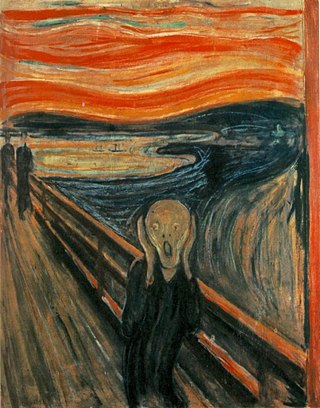Related Research Articles

Anxiety is an emotion characterised by an unpleasant state of inner turmoil and includes feelings of dread over anticipated events. Anxiety is different from fear in that fear is defined as the emotional response to a present threat, whereas anxiety is the anticipation of a future one. It is often accompanied by nervous behavior such as pacing back and forth, somatic complaints, and rumination.

Anxiety disorders are a group of mental disorders characterized by significant and uncontrollable feelings of anxiety and fear such that a person's social, occupational, and personal functions are significantly impaired. Anxiety may cause physical and cognitive symptoms, such as restlessness, irritability, easy fatigue, difficulty concentrating, increased heart rate, chest pain, abdominal pain, and a variety of other symptoms that may vary based on the individual.
Glossophobia or speech anxiety is the fear of public speaking. The word glossophobia derives from the Greek γλῶσσα glossa (tongue) and φόβος phobos The causes of glossophobia are uncertain but explanations include communibiology and the illusion of transparency. Further explanations range from nervousness produced by a lack of preparation to, one of the most common psychiatric disorders, social anxiety disorder (SAD).
Psychology is an academic and applied discipline involving the scientific study of human mental functions and behavior. Occasionally, in addition or opposition to employing the scientific method, it also relies on symbolic interpretation and critical analysis, although these traditions have tended to be less pronounced than in other social sciences, such as sociology. Psychologists study phenomena such as perception, cognition, emotion, personality, behavior, and interpersonal relationships. Some, especially depth psychologists, also study the unconscious mind.

Avoidant personality disorder (AvPD), or anxious personality disorder, is a cluster C personality disorder characterized by excessive social anxiety and inhibition, fear of intimacy, severe feelings of inadequacy and inferiority, and an overreliance on avoidance of feared stimuli as a maladaptive coping method. Those affected typically display a pattern of extreme sensitivity to negative evaluation and rejection, a belief that one is socially inept or personally unappealing to others, and avoidance of social interaction despite a strong desire for it. It appears to affect an approximately equal number of men and women.
Ergophobia is described as an extreme and debilitating fear associated with work, a fear of finding or losing employment, or fear of specific tasks in the workplace. The term ergophobia comes from the Greek "ergon" (work) and "phobos" (fear).

Perfectionism, in psychology, is a broad personality trait characterized by a person's concern with striving for flawlessness and perfection and is accompanied by critical self-evaluations and concerns regarding others' evaluations. It is best conceptualized as a multidimensional and multilayered personality characteristic, and initially some psychologists thought that there were many positive and negative aspects.
Cognitive restructuring (CR) is a psychotherapeutic process of learning to identify and dispute irrational or maladaptive thoughts known as cognitive distortions, such as all-or-nothing thinking (splitting), magical thinking, overgeneralization, magnification, and emotional reasoning, which are commonly associated with many mental health disorders. CR employs many strategies, such as Socratic questioning, thought recording, and guided imagery, and is used in many types of therapies, including cognitive behavioral therapy (CBT) and rational emotive behaviour therapy (REBT). A number of studies demonstrate considerable efficacy in using CR-based therapies.
Social inhibition is the conscious or subconscious avoidance of a situation or social interaction. With a high level of social inhibition, situations are avoided because of the possibility of others disapproving of their feelings or actions. Related processes that deal with social inhibition are social evaluation concerns, anxiety in social interaction, social avoidance, and withdrawal. Also related are components such as cognitive patterns, anxious apprehension during social interactions, and internalizing problems. It also describes those who suppress anger, restrict social behavior, withdraw in the face of novelty, and have a long latency to interact with strangers.
The Liebowitz Social Anxiety Scale (LSAS) is a short questionnaire developed in 1987 by Michael Liebowitz, a psychiatrist and researcher at Columbia University and the New York State Psychiatric Institute. Its purpose is to assess the range of social interaction and performance situations feared by a patient in order to assist in the diagnosis of social anxiety disorder. It is commonly used to study outcomes in clinical trials and, more recently, to evaluate the effectiveness of cognitive-behavioral treatments. The scale features 24 items, which are divided into two subscales. 13 questions relate to performance anxiety and 11 concern social situations. The LSAS was originally conceptualized as a clinician-administered rating scale, but has since been validated as a self-report scale.
Neuroticism is a personality trait associated with negative emotions. It is one of the Big Five traits. Individuals with high scores on neuroticism are more likely than average to experience such feelings as anxiety, worry, fear, anger, frustration, envy, jealousy, pessimism, guilt, depressed mood, and loneliness. Such people are thought to respond worse to stressors and are more likely to interpret ordinary situations, such as minor frustrations, as appearing hopelessly difficult. Their behavioral responses may include procrastination, substance use, and other maladaptive behaviors, which may temporarily aid in relieving negative emotions and generating positive ones.
Test anxiety is a combination of physiological over-arousal, tension and somatic symptoms, along with worry, dread, fear of failure, and catastrophizing, that occur before or during test situations. It is a psychological condition in which people experience extreme stress, anxiety, and discomfort during and/or before taking a test. This anxiety creates significant barriers to learning and performance. Research suggests that high levels of emotional distress have a direct correlation to reduced academic performance and higher overall student drop-out rates. Test anxiety can have broader consequences, negatively affecting a student's social, emotional and behavioural development, as well as their feelings about themselves and school.

Dental fear, or dentophobia, is a normal emotional reaction to one or more specific threatening stimuli in the dental situation. However, dental anxiety is indicative of a state of apprehension that something dreadful is going to happen in relation to dental treatment, and it is usually coupled with a sense of losing control. Similarly, dental phobia denotes a severe type of dental anxiety, and is characterized by marked and persistent anxiety in relation to either clearly discernible situations or objects or to the dental setting in general. The term ‘dental fear and anxiety’ (DFA) is often used to refer to strong negative feelings associated with dental treatment among children, adolescents and adults, whether or not the criteria for a diagnosis of dental phobia are met. Dental phobia can include fear of dental procedures, dental environment or setting, fear of dental instruments or fear of the dentist as a person. People with dental phobia often avoid the dentist and neglect oral health, which may lead to painful dental problems and ultimately force a visit to the dentist. The emergency nature of this appointment may serve to worsen the phobia. This phenomenon may also be called the cycle of dental fear. Dental anxiety typically starts in childhood. There is the potential for this to place strains on relationships and negatively impact on employment.
Social anxiety is the anxiety and fear specifically linked to being in social settings. Some categories of disorders associated with social anxiety include anxiety disorders, mood disorders, autism spectrum disorders, eating disorders, and substance use disorders. Individuals with higher levels of social anxiety often avert their gazes, show fewer facial expressions, and show difficulty with initiating and maintaining a conversation. Social anxiety commonly manifests itself in the teenage years and can be persistent throughout life; however, people who experience problems in their daily functioning for an extended period of time can develop social anxiety disorder. Trait social anxiety, the stable tendency to experience this anxiety, can be distinguished from state anxiety, the momentary response to a particular social stimulus. Half of the individuals with any social fears meet the criteria for social anxiety disorder. Age, culture, and gender impact the severity of this disorder. The function of social anxiety is to increase arousal and attention to social interactions, inhibit unwanted social behavior, and motivate preparation for future social situations.

The Beck Anxiety Inventory (BAI) is a formative assessment and rating scale of anxiety. This self-report inventory, or 21-item questionnaire uses a scale ; the BAI is an ordinal scale; more specifically, a Likert scale that measures the scale quality of magnitude of anxiety.
Positive affectivity (PA) is a human characteristic that describes how much people experience positive affects ; and as a consequence how they interact with others and with their surroundings.

Social anxiety disorder (SAD), also known as social phobia, is an anxiety disorder characterized by sentiments of fear and anxiety in social situations, causing considerable distress and impairing ability to function in at least some aspects of daily life. These fears can be triggered by perceived or actual scrutiny from others. Individuals with social anxiety disorder fear negative evaluations from other people.
Separation anxiety disorder (SAD) is an anxiety disorder in which an individual experiences excessive anxiety regarding separation from home and/or from people to whom the individual has a strong emotional attachment. Separation anxiety is a natural part of the developmental process. It is most common in infants and little children, typically between the ages of six to seven months to three years, although it may pathologically manifest itself in older children, adolescents and adults. Unlike SAD, normal separation anxiety indicates healthy advancements in a child's cognitive maturation and should not be considered a developing behavioral problem.
The Social Interaction Anxiety Scale (SIAS) is a self-report scale that measures distress when meeting and talking with others that is widely used in clinical settings and among social anxiety researchers. The measure assesses social anxiety disorder, which is fear or anxiety about one or more social situations where the individual is subject to possible scrutiny.
References
- ↑ "Fear of Failure (Atychiphobia): Causes & Treatment". Cleveland Clinic. Retrieved 2023-03-14.
- ↑ Ph.D, Irena Milosevic; Ph.D, Randi E. McCabe (2015-03-03). Phobias: The Psychology of Irrational Fear: The Psychology of Irrational Fear. ABC-CLIO. ISBN 978-1-61069-576-3.
- ↑ Watson, D.; Friend, R. (1969). "Measurement of Social-evaluative Anxiety". Journal of Consulting and Clinical Psychology . 33 (4): 448–57. doi:10.1037/h0027806. PMID 5810590.
- 1 2 Leary, M. (1983). "A Brief Version of the Fear of Negative Evaluation Scale" (PDF). Personality and Social Psychology Bulletin . 9 (3): 371–75. doi:10.1177/0146167283093007. S2CID 144875099. Archived from the original (PDF) on 23 January 2013. Retrieved 13 November 2012.
- ↑ Schlenker, B (1980). Impression Management: The Self-concept, Social Identity, and Interpersonal Relations. Monterey, CA: Brooks/Cole Publishing.
- 1 2 3 Andrews, F (1991). Measures of Personality and Social Psychological Attitudes. San Diego, CA: Gulf Professional Publishing.
- 1 2 Stein, M.; Jang, K.; Livesley, W. J. (2002). "Heritability of Social Anxiety-related Concerns and Personality Characteristics: a Twin Study". Journal of Nervous and Mental Disease . 190 (4): 219–224. doi:10.1097/00005053-200204000-00002. PMID 11960082. S2CID 44689870.
- ↑ Ledley, Deborah Roth (2006). Cognitive phenomena in social anxiety disorder. Hillsdale, NJ: Erlbaum. pp. 251–283.
- 1 2 Mansell, W.; Clark, D. M.; Ehlers, A.; Chen, Y.P (1999). "Social anxiety and attention away from emotional faces". Cognition and Emotion. 13 (6): 673–690. doi:10.1080/026999399379032.
- ↑ Levinson, Cheri A.; Rodebaugh, Thomas L. (January 2012). "Social anxiety and eating disorder comorbidity: The role of negative social evaluation fears". Eating Behaviors. 13 (1): 27–35. doi:10.1016/j.eatbeh.2011.11.006. ISSN 1471-0153. PMC 3244677 . PMID 22177392.
- ↑ Winton, E.; Clark, D.; Edelmann, R. (1995). "Social Anxiety, Fear of Negative Evaluation and the Detection of Negative Emotion in others". Behaviour Research and Therapy. 33 (2): 193–196. doi:10.1016/0005-7967(94)e0019-f. PMID 7887878.
- ↑ Fas, N.; Page, A.; Serfaty, C.; Tai, V.; Winkler, C. (2008). "Speaker overestimation of communication effectiveness and fear of negative evaluation: Being realistic is unrealistic" . Psychonomic Bulletin & Review. 15 (6): 1160–1165. doi:10.3758/pbr.15.6.1160. PMID 19001584. S2CID 15997486.
- ↑ Mesagno, Christopher; J. Harvey; C. Janelle (2012). "Choking under pressure: The role of fear of negative evaluation". Psychology of Sport & Exercise. 13 (1): 60–68. doi:10.1016/j.psychsport.2011.07.007. hdl:1959.17/57510.